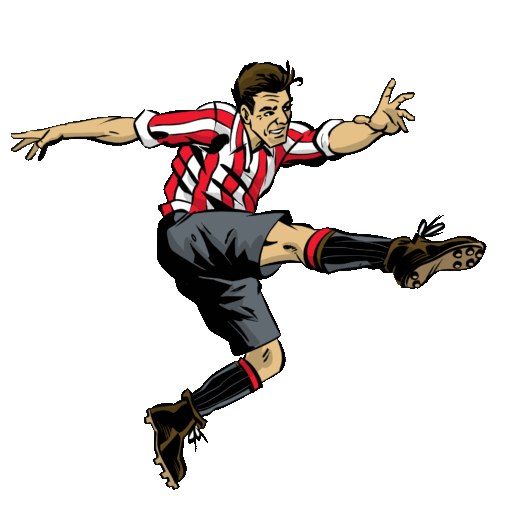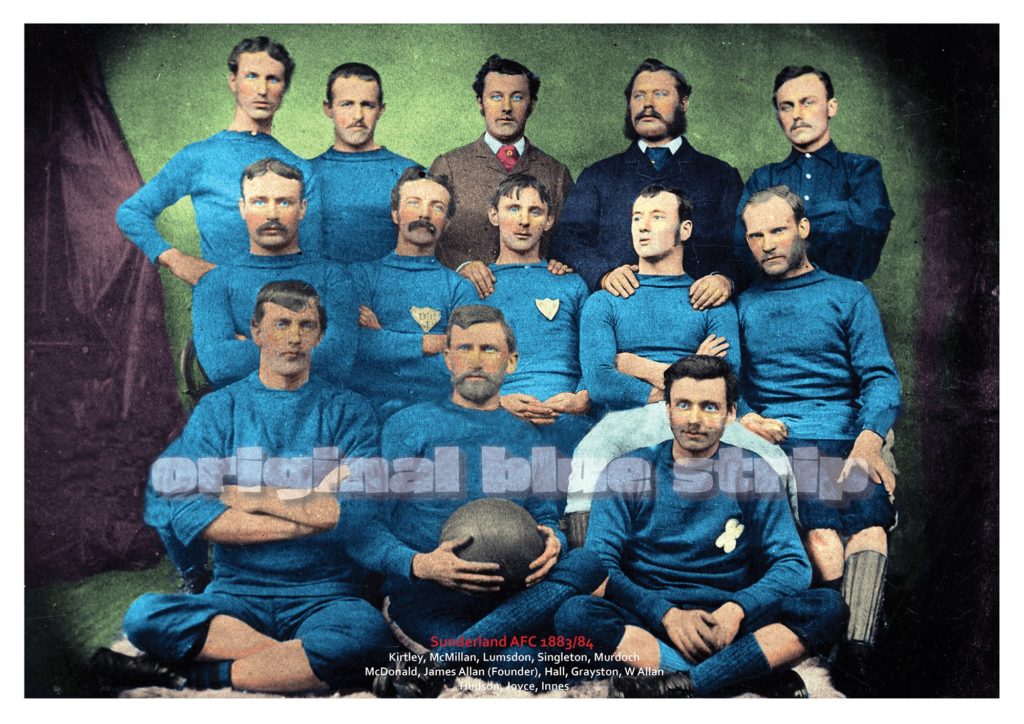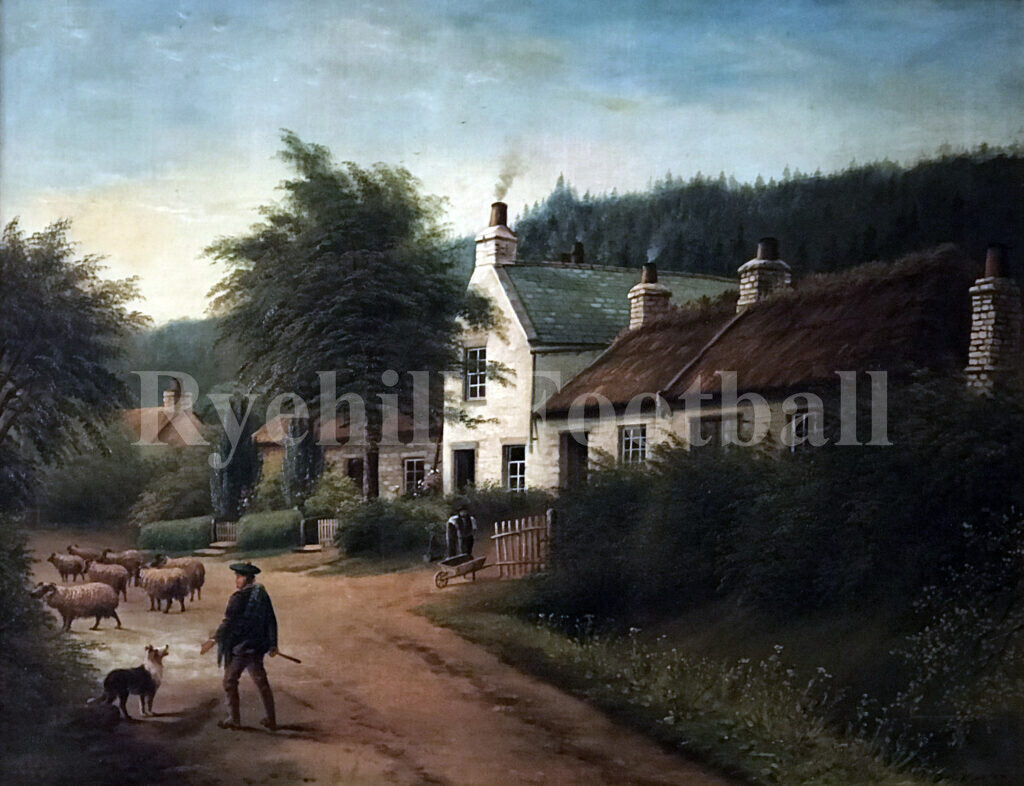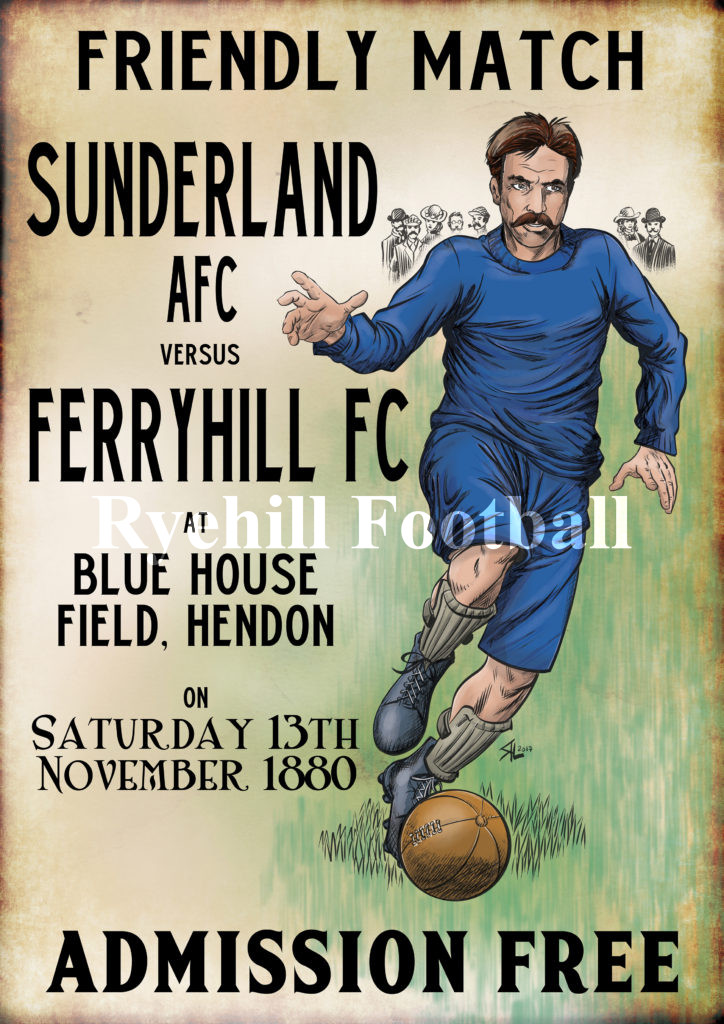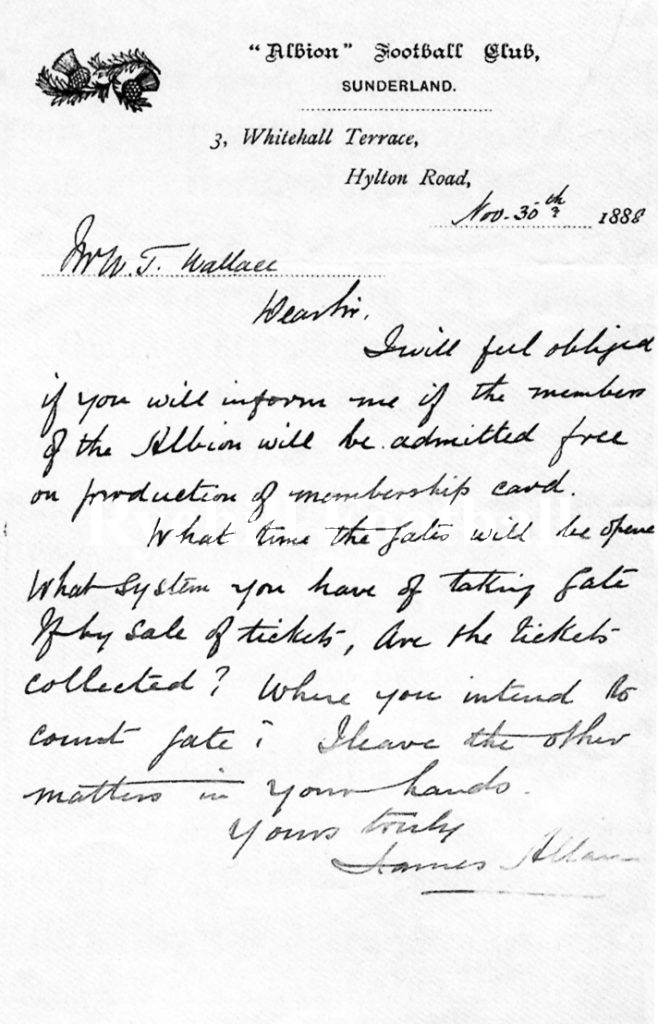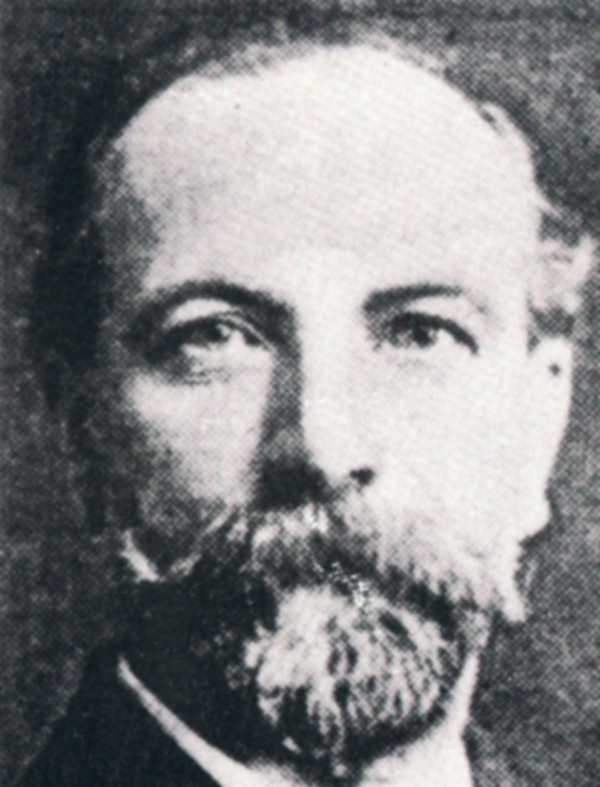James Allan
- School Master, Footballer, Football Administrator
- Born – 9 October 1857, Green Street, Ayr, Scotland
- Died – 18 October 1911, Elmwood Street, Sunderland, England
James Allan pictured second from the left in the middle row in the earliest surviving image of an SAFC team
Sunderland AFC was formed by a Scotsman, James Allan.
James Allan was born on 9th October 1857 in Green Street, Ayr, Scotland, to father William (a shoemaker) and Mother Hellen. These details are available from the 1911 Census return.
The above painting is signed and dated “A Drinkwater 1891” and was painted by Albert Milton (later known as Milton) Drinkwater (1862-1923). Although the buildings in this painting have long since gone and are replaced by modern bungalows, the surrounding background still exists and gives credence that this was Milton Hamlet, stair, Ayrshire at the turn of the 19th– 20th century. It is believed that William and Hellen Allan and their children lived in the centre two storied house, which is described as Milton House or Toll House in various censuses and other documents. James Allan grew up here.
It is universally stated that he arrived in Sunderland from Glasgow University, sometimes indicating that he was a graduate; however, investigations provide a slightly different story.
We know that Allan finished his education at the Glasgow Training College, and afterwards studied medicine for 12 months at the university, but finally decided not to go into that profession (see further information below), but to become a master.
During his residence in Glasgow, he played for several of the foremost clubs of that city, amongst others the Oxford (Crosshill, Glasgow), the East Kilbride (Lanarkshire), and the Busby (Busby, Renfrewshire). He also used to practice regularly with the Third Lanark Rifle Volunteers F.C., at that time the premier club in Scotland, and he was offered a place in their second eleven, but at the time was leaving for Sunderland.
There is record of him enrolling for the summer term at Glasgow University in both 1877 (to study medicine) and 1878 (to study botany), but there is no indication that he was a permanent student, and no record of him graduating.
It would appear his association with Glasgow University was a temporary one only, a means of supplementing his studies whilst pursuing his chosen career, teaching. The University of Strathclyde Archives have provided a very detailed description of his successful completion of Teacher Training during the years 1876 and 1877:
“… a student called James Allan does appear in the ‘Register of Students’ Certificates’ for the Glasgow Church of Scotland Training College (archive reference: CSTC/2/3). He was born on 9th October 1857 and passed the College’s entrance examination for male candidates at Christmas 1875. The teacher training course took two years, and covered science subjects (magnetism and electricity, physiology and geology) as well as drawing. James Allan completed the course and left the College at Christmas 1877, having obtained final marks of VG [very good] for Arithmetic, G [good] for Geometry, and VF [very fair] for Algebra. Unfortunately, the Register does not indicate where he went on to teach after he finished the course.”
Without doubt then, Allan had qualified as a teacher at the end of 1877, aged 20. We have no track of him in 1878, but it is reasonable to assume that he was probably gaining experience as a teacher in a school in Scotland, probably in the Glasgow area; and topping up his knowledge with lectures in Botany given at Glasgow University during May, June and July of that year.
James Allan was appointed second assistant master at Hendon Boys School in April 1879 at a salary of £60 per annum rising to £90. We can be fairly precise with the date as the Sunderland Daily Echo reported in its Wednesday 9 April 1879 edition on a meeting of the Sunderland School Board. This was a usual monthly meeting and was presided over by a Mr R Cameron. A brief discussion took place over the previous minutes of the March meeting and then they turned to rubber stamping various recommendations. One of which was “that James Allan be appointed as second Assistant Master in Hendon School on the usual terms”. It was a lengthy meeting but the important part, as far as the history of Sunderland AFC is concerned, was over.
The original board schools were formed as a result of the Elementary Education Act 1870 following intense campaigning by the National Education League. They were ultimately abolished as part of the Education Act 1902 which replaced them with local education authorities.
The legend is that Allan returned from a holiday in Scotland bringing with him a round football and teachers alike joined him in kicking the ball around in the Hendon school yard. At the school with James Allan was another teacher, John Grayston, who wrote an unfinished series of articles in the short-lived Sunderland Weekly News in September 1931, half a century later. He reminisced about the early years and claimed that he had clear memory of kick abouts in that school yard, a yard he calls the “actual and spiritual home of Sunderland.”
Allan, disappointed at the lack of football in his adopted town, proposed to another teaching colleague, Walter Chappell, that they should form a club. “Well’, said Chappell, “I know nothing about the game, but I’ll do the talking-for you.”
In Grayston’s series he states the following; “Jimmy must be “blamed” for the inauguration of the association game in Sunderland”, restating this with another salient point “of course Jimmy conceived the idea of forming a football team and I became secretary and convener”.
The issues surrounding the formation of Sunderland AFC are discussed elsewhere on this site.
James Allan is represented in the above football art print depicting the clubs founder playing in SAFC’s first recorded game
James Allan was a complex and often unpopular character but successful in his teaching career, so much so that on leaving Hendon Board School he moved on to teaching at Thomas Street School until finally becoming the Headmaster of Hylton Road School until, his death in 1911. His various moves were reported in the local press, for example we know that, on Tuesday 17 May 1881 a meeting of the Sunderland School Board was held in John Street, Sunderland. Mr R Cameron was once again the presiding Chairman. A number of items were on the agenda and discussed starting with the report of the Finance and Works Committee. Next the Educational Committee report was presented and discussed but it was the third item, General Purposes Committee matters that would have a bearing on Allan. It was recommended that “Mr James Allan be appointed first assistant master in Thomas Street Boys School and that the clerk be instructed to advertise for a second assistant master at Hendon Boys (sic) School”. On the motion of a Dr Morgan and seconded by a Mr Kirk the General Purposes Committee report was adopted.
After little more than 24 months since his arrival in the then town James Allan career in Sunderland was on the move upwards.
At its next meeting on Tuesday 14 June 1881 the details of Allan’s new salary were revealed. His starting salary would be £90 per annum, rising by £5 per annum to a maximum of £100.
On Thursday 30 June 1881 Allan was presented with a “handsome silver watch” by both the teachers and scholars of the Hendon Board School in appreciation of his endeavours with and for them. It is fair and logical to presume that this was his formal leaving event and his last day as second assistant master.
On Friday 5 August 1881 there was a pre-season meeting of the football club. At that get together the appointment of Bob Singleton as captain for the season was confirmed but James Allan stepped down as vice captain and in his place R Roberts was elected. The decision of the clubs founder not to stand for the position of vice captain coincides with a scarcity of club and team information being sent to and reported upon by the Sunderland Daily Echo. Other than some fairly brief match reports, there is, in sharp contrast to the previous season and subsequent seasons, an almost total lack of information.
It can perhaps be surmised that having taken up his new teaching position at Thomas Street, Allan became preoccupied for a while with his career, which could suggest that it was Allan who was the one previously feeding the press with snippets about the club, including any meetings.
As a player he was notionally an outside left and was a prolific goalscorer. However, to counter this he was very often accused of dishing out “rough play” on the opposition in a needless underhand way. He could be a selfish ball player which often left his teammates exasperated. Due to his slight physique he was often referred to as “The Boneless Wonder”.
However, his footballing exploits were enough for him to be recognised by The Rangers club from Newcastle, for example, who recruited Allan to play for them against the then mighty Queens Park from Glasgow in the 1882/83 season. Although The Rangers team lost James Allan “raised cheer after cheer by his determined play, dribbling nearly the whole length of the field time after time”.
On Saturday 12 May 1883 the Northumberland and Durham FA held a sports day at the North Durham track at Prince Consort Road, Gateshead to formally end their association before they split into two separate bodies. It was a good day for James Allan who won the dribbling race. It was also another good day for Allan in December 1884 in the game against Castletown.
Sunderland AFC 23 v 0 Castletown, Friendly
(Originally a Durham Challenge Cup tie)
Abbs Field, Fulwell, Sunderland; Saturday 20 December 1884
Scorers: Unknown
The game with Castletown on December 20th was to be a first round Durham Challenge Cup tie, but Castletown arrived at Abbs Field with only eight men, for some new players failed to turn up. Castletown conceded the tie to Sunderland but to keep faith with the crowd, Sunderland loaned them three second team men, and a game was played.
Buried in the pages of an extinct newspaper is Ronald’s description of a momentous victory. Everything went wrong for Castletown. They lost the toss, had to face wind and rain, conceded seven goals in the first 15 minutes and no less than 16 in the first half, “with the wind at their backs, it was now thought the visitors would score.” But, sadly, “all efforts to pass the half backs were stopped by McMillan and Elliott. At the call of time the score stood at 23 goals to nil”.
Rather obviously, Ronald tells us that “the home forwards played well, making repeated visits to goal, while Grayston at centre forward played very affectionate attentions to the visitors’ goalkeeper.” This goalkeeper, the nameless victim of the Sunderland onslaught, won special praise, for he gave a plucky display. “Their goalkeeper played a good game for the losers” is the laconic, and doubtless sarcastic comment in a Newcastle paper. At the other end of the field, Ronald tells us, the time of the Sunderland backs was taken up in “consoling our starving goalkeeper whose only duty consisted in mere marking down the score.”
The Newcastle Journal indicated that: “This game was originally intended to be a Durham County Cup tie but the visitors turned up 3 players short and scratched in favour of the home side who are the current Cup holders. A game was still arranged with Castletown borrowing 3 Sunderland reserve players to bring them up to strength. The visitors were absolutely overwhelmed and in the 90 minutes play Sunderland ran in 23 goals. Briggs, Nicholson and the Castletown goalkeeper played well for the losers in a game that was umpired by Dr. Wilson of Birtley”.
A windy wet December day thus gave us the club’s record victory, although it is rarely mentioned today among the achievements. At the time, the Echo was jubilant, claiming that the club had topped the previous best ever score of 17 by one of the Blackburn clubs in a Cup-tie in the previous season, by “six notches.” If this is indeed the case, then by a judicious stretching of the definition of a “contest”, possibly Sunderland AFC can claim that at one time they held the highest ever score?
It’s likely that the match The Echo was referring to was the 15 v 0 hiding dished out by Queens Park to Manchester in the 1883/84 FA Cup tie second round match in Scotland. In 1887 Preston North End would eclipse this score by Sunderland when they defeated Hyde in the FA Cup 26 v 0.
John Grayston makes mention of this match in his 1931 SAFC memoirs, as follows: “On the other hand Colonel Briggs, from Hylton, challenged us to a friendly. His sister rode round the field on horseback to cheer her brother on. We got 22 goals to none or one. I cannot just remember. Modesty compels me to say I got some of them, but the half-backs and backs were so envious that we opened out and allowed them to score!”
Alas and unfortunately we have no line-ups for this game and no details of the scorers. There is legend that James Allan scored 12 of the goals and as he was such a prolific striker that does not appear to be beyond the realms of possibility.
In the 1884/85 seasons Allan was accused of bribing one of the Birtley backs, Watson, to the tune of £2 to “play a dummy game”. Incensed Allan threatened legal action, in his usual straight to the point – go for the jugular manner. No further action was pursued by Birtley.
Although Allan played in many friendly and Durham Challenge Cup games for Sunderland his record shows that he featured in just 3 competitive fixtures for the club, all FA Cup ties, including the clubs very first professional match which was the Redcar cup tie in November 1884.
Allan took an active part in football all his life, holding the position of Treasurer at the time he left Sunderland AFC, and then of course leading the breakaway that formed Sunderland Albion in 1888, a move that almost saw the death of Sunderland AFC. He was also at one point the Chairman of the Wearside League.
On Tuesday 13 March 1888 James Allan held a meeting at The Empress Hotel in Union Street to form Sunderland Albion. Seven Sunderland players would defect to Albion along with Sunderland AFC’s first President, Alderman Potts. The reasons for Allan’s dissatisfaction were never well recorded although we know that there was a dispute over professionalism at SAFC, an inference that Scots players were being favoured over their English counterparts and there was the disqualification from a cup competition following a match against Middlesbrough.
At the time The Sunderland Echo were sending out some mixed messages about SAFC, without stating the actual problem and it would seem logical to conclude that The Echo knew about the impending formation of Albion.
Sunderland Albion were rumoured to be backed by some wealthy individuals, most noticeably James Hartley, who along with his brother John owned the Wear Glass Works at Monkwearmouth, founded in 1837. The backing arose from James Allan’s friendship with Hartley; they were neighbours, Allan living nearby in Whitehall Terrace. Furthermore there is evidence to suggest that Albion were also backed by wealthy brewers and players such as James Hannah, for example, became landlord of the Free Gardeners Arms in Williamson Terrace.
On Saturday 14 April 1888 the Shields Daily Gazette reported upon the very first floodlit game in the North East region and possibly one of the first in the world. The game, the previous night, between Palmer’s Hill FC and North Sands Rovers, played on The Ashville Ground, Newcastle Road, Sunderland (home of course to Sunderland AFC) used ten “Wells Light(s)” to illuminate the pitch. The sides included a liberal sprinkling of current and former Sunderland AFC players, including Kirtley, Monaghan, Kilpatrick, Hastings, Potts, Dale, Moore, Rooney, Davison and Gloag. Each light had 4,000 candle power. The game played over two halves of thirty minutes was very well attended and judged to be a great success. The game incidentally resulted in a 2 vs. 2 draw. James Allan acted as one of the umpires. The game was separately reported upon in the 20 April 1888 edition of The Newcastle Courant and The Sunderland Echo on 14 April 1888.
James Allan turned up for the Sunderland AFC annual meeting on 3 May 1888 to present his treasurers report. It was his last official act. At that meeting there is no thank you to James Allan together with an announcement of his departure. Furthermore if he had publically announced the formation of Albion by that time you would have thought that he would have been persona non gratis at that meeting. Albion subsequently played their first football match two days after the SAFC annual meeting, at Shankhouse.
The rivalry between Sunderland AFC and Sunderland Albion became intense and often bitter, spilling over into unsavoury activities, none more so than the January 1889 encounter, which Sunderland won 3 v 2 and led to an FA inquiry. Allan was at the heart of the after match provocations and accusations. Albion walked off the pitch due to a dispute over the scoring of a goal and by walking off they lost a great deal of sympathy over what appeared to be an incorrect decision. Regrettably this was manifest in unpleasant scenes as the Albion team left the ground in their brake for the Waverley Hotel. They were followed by a howling crowd and several stones were thrown with 3 or 4 of the Albion players being hit. J Stewart was struck on the forehead and James Allen, who acted as the Albion umpire, was hit in the corner of his eye. He was taken to Mr Davis surgery to have his wound attended to.
On 5 March 1890 a meeting was held at The Empress Hotel in Union Street to consider the advisability of converting the Sunderland Albion club and bicycle track into a limited liability company. There was a large attendance and Mr WS Glass presided. After discussing the position of the club it was unanimously decided to form a company “Sunderland Albion Association football and Athletic Club Limited” with a capital of £3,000 divided into shares of £1 each. James Allan was named as one of the directors of the football club.
He was always a very fit man and attempted to cycle from Sunderland to Glasgow to witness the 5 April 1890 Scotland vs. England encounter at Hampden Park. He was thwarted when his bike gave up on him at Edinburgh!
He also gained representative honours with both County Durham and Northumberland.
By the time of the 1911 census, in the year of Allan’s death he was living with the following members of his family at his home; 37 Elmwood Street, Sunderland:
- Priscilla Allan (wife, aged 49 – the couple were married for 32 years, born Church Street, Sunderland)
- Daisy Allan (daughter, aged 24, single, shop assistant)
- Wallace Allan (son, aged 20, single, Apprentice Engineer, Shipbuilding)
- Violet Allan (daughter, aged 32, single, domestic servant at a private home)
- Helen Allan (daughter, aged 13, at school)
- Arthur Allan (grandson, aged 3 – and son of Walter James Allan – see below)
The census also showed that Allan’s Family had lived at various locations in the then town; Rock Terrace, Whitehall Terrace (both near Chester Road/Hylton Road), Kayll Road and Ewesley Road.
James and Priscilla Allan had another son, Walter James Allan who was born in 1881 and died on the SS Halifax in 1917. Walter would have been around 30 at the time of the 1911 census and it is thought that he may have been at sea at the time. They also had another daughter; Lily Allan who was born in 1885 and died in 1951.
James Allan died on 18 October 1911. The death certificate gives his occupation on the date of death as a School Master. His passing was registered in the Sunderland West Sub-District by his son Wallace on the day he died with the cause of death given by James Chalmers MD as Apoplexy. This is a general medical term given to someone who passes away very quickly from, for example, a sudden heart attack therefore we know that the club’s founder did not suffer in his passing.
Allan was just 54 years of age.
He was buried at Bishopwearmouth Cemetery on Saturday 21 October 1911 and his funeral was well attended by 130 students from Hylton Road School where Allan was head teacher, representatives from the National Union of Teachers (NUT) and members of the various Freemason Lodges in Sunderland (Allan was a Past Master and Secretary of The Wearmouth Lodge). His coffin was made of pitch pine, with brass mountings and bore the inscription; “James Allan, died October 18 1911, aged 53 years”. The Reverend AL Broadfield minister of the Mount Tabor Methodist Church, Chester Road, officiated.
A notable attendee was James Allan’s sister; Mrs Jardine of Glasgow. John Grayston, Headmaster at Chester Road School, and there with Allan at the founding of Sunderland AFC, was present. As expected numerous floral tributes were received, including a wreath from SAFC. Finally and interestingly a number of his family attended from Stillington in North Yorkshire, and it is known that some of Allan’s family moved in the direction of Lytham St Anne’s and Blackpool.
In January 1912 it was further reported that his will had been read and his estate of £1477 (£378 net) had been left to his wife and probate, Priscilla.
Football wise Allan sits alongside Charles Alcock as the finest and most influential sports administrators the City has ever produced. Considering Alcock is widely regarded as The Father of Modern Sport that is some feat by Allan.
As a postscript to the James Allan story; in December 1913 The Sunderland Echo reported that Daisy Allan (1886 to 1969) had married William Gopsill of London and we know that Violet Allan (1888 to 1982) subsequently ran a boarding house in Bishop Auckland. Arthur Allan, James grandson (and the son of Walter James Allan – see above) died at sea in 1939 onboard the SS Deptford, aged 32, when it was sunk by a U Boat on 13 December of that year.
James’s son, Wallace “Monty” Allan, of Ormonde Street, Sunderland was ultimately killed aboard the ship Kildare, partly destroyed by German bombers, in February 1940 although there was a twist to this tale when the Kildare was hit by 2 bombs, only one of which exploded. The other was diffused back in Immingham near Grimsby, with the ship having limped back to England. A George Cross was subsequently awarded as part of this tale (refer to link). Therefore both of James and Priscilla’s sons, as well as their grandson, were killed at sea.
With thanks to Statcat and Steven Paterson (a relation of James Allan) for their contribution to this article.
Sunderland supporters can download a copy of the PDF that appeared in the local Sunderland newspaper recording the death of James Allan in 1911.
